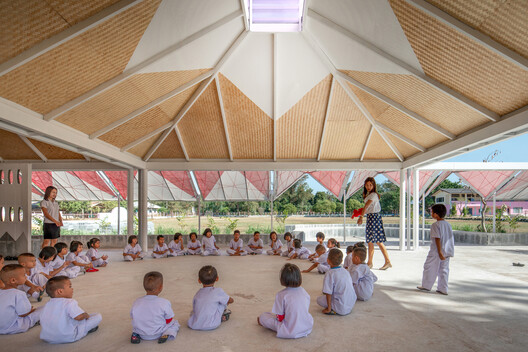Project Highlight No. 1: Ecuador’s CSF Centre for People with Disabilities
Architects engaged the community, families, craftspeople, and children in a participatory design approach at the CSF Centre for People With Disabilities. They collaborated to design accessible, playful areas with low walls, climbing features, and textured walks using workshops, sketches, and even large-scale printed designs. In addition to promoting discovery and closeness, this multisensory setting incorporates children’s artwork into the structure itself.

Credit Rizvi Hassan
Project Spotlight 2: Evergreen, Canada’s Climate-Ready Schoolyards
Children are invited to participate in the planning and design of school grounds using Evergreen’s Child-Friendly Participatory Design approach. These experiences, which include model-making, arts-based mapping, and flexible, age-appropriate workshops held where children feel most at ease (such as their school or community centre), are designed to be inclusive, participatory, enjoyable, and location-based.
Why it’s empowering: Children learn collaborative decision-making and have a say in design choices, transforming their concepts into real settings they love.

Image source evergreen.ca
Boston Schoolyard Initiative, USA: Project Spotlight 3
The Boston Schoolyard Initiative creates lively outdoor learning spaces in abandoned schoolyards. The program has revitalised dozens of school sites by establishing creative, useful outdoor classrooms and play areas through a community participatory design process that involves kids, educators, city authorities, and citizens.
Why it’s empowering: Kids take charge of public areas and witness their visions come to life, which fosters civic pride and innovative thinking.

Image source outdoorplaybook.ca
Project Highlight 4: StreetScape—A Tactile City Structure for Children with Visual Impairments
StreetScape is a tactile, inclusive street puzzle that allows both sighted and blind children to work together to create a city. This gamified, hands-on platform, which includes 3D-printed tiles and tactile highways, encourages cross-sensory collaboration, accessibility, and spatial learning through enjoyable, group-driven assembly.
It bridges educational gaps, develops empathy, and gives kids both tactile and creative agency—especially in inclusive learning environments—which is why it’s empowering.

Image source www.freepik.com
Project Spotlight 5: Co-Designing Games for Neurodiverse Classrooms with PartiPlay
For classrooms with neurodiverse students, PartiPlay provides a design kit for interactive games. It was created using inclusive co-design and takes into account different learning preferences, sensory requirements, and communication styles. According to preliminary testing, this tool supports a fair and fulfilling design process for kids with neurodiverse traits.
Because it views neurodiversity as a strength, it empowers kids to shape game design according to their preferences and produce genuinely inclusive experiences.
Image source web.tecnico.ulisboa.pt
Similar Guidelines for All of These Projects
Several important themes come to light across these various initiatives:
- Child-Centered Collaboration
Initiatives value children’s opinions and life experiences by presenting them as co-creators rather than merely participants.
- Sensory-Rich & Inclusive Approaches
All learning types will find the activities, which range from tactile tiles to model construction and creative workshops, to be interesting and accessible. - Local Identity & Context
These designs speak to children’s own surroundings and cultural settings, whether they are displayed on school property or in public spaces. - Two Advantages
In addition to empowering kids, these initiatives frequently provide better, more creative results and strengthen ties throughout the community.
Useful Advice for Starting Kids’ Participatory Projects
This mini-toolkit will help you get started:
Adopt Cooperative Inquiry Methods:
Although it is outside the scope of our blog, cited here, use well-established frameworks such as Cooperative Inquiry to include children as full design collaborators.
Use Playful, Hands-On Tools:
To make participation concrete, use tactile kits, narrative, model-making, mapping, or puzzle formats (such as StreetScape).
Hosting Inclusive Workshops
Provide flexible formats, sensory breaks, and a variety of engagement styles when hosting inclusive workshops. Evergreen’s guidelines are a fantastic resource for this.
Incorporate Local Voices:
As in the CSF Centre and Evergreen programs, hold courses in familiar locations (schools, community centres) and include regional customs, culture, or artwork.
Celebrate Outcomes Publicly:
To recognise children’s efforts and encourage them, display designs, installations, or results.
Conclusion: Working with Children to Design for the Future
Using children in participatory design is a transformative technique, not merely a fad. Working together with young users fosters empathy, creativity, and a sense of agency that will influence the future. These five projects, which range from inclusive design kits to tactile city puzzles, show that inclusive, significant, and remarkable results can be achieved when kids are genuinely involved in the creative process.
For more blogs like this CLICK HERE
Reference
Designing with Kids: 5 Participatory Projects that Empower Young Users | ArchDaily





